Whose Studios?
So by the late ’80s, both Disney and Universal were moving full speed ahead on opening new studio-based theme parks in Orlando – Disney’s anchored by its own take on a tram tour and the “Great Moments at the Movies” ride once planned for Epcot; Universal’s anchored by the components of its Hollywood studio tour separated out into standalone attractions.

So whose studios would the public choose?
Universal had both classic films from its 75-year history (Frankenstein, Dracula, The Wolf Man, and more) and contemporary hits (King Kong, Jaws, Earthquake, and Back to the Future to name a few). In a park determined to celebrate the heralded history of Hollywood and the showstoppers of today, Universal was unbeatable.
Disney? Not so much. A tarnished brand with limited historical significance, no current hits, and seemingly little on the horizon, a park relying only on Disney’s name and characters would like entirely illegitimate next to an industry titan like Universal. Disney in the 1980s was a shadow of its former self.
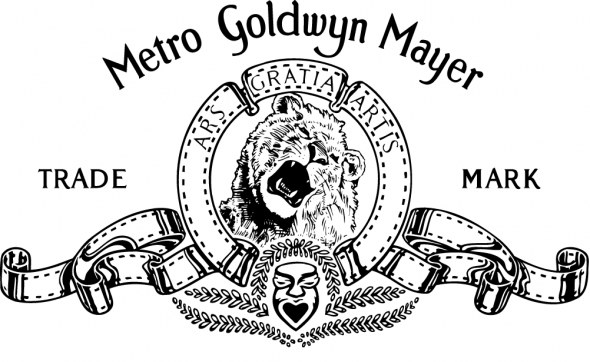
But so was Metro-Goldwyn-Mayer (MGM). The difference is, MGM had the legacy that Disney lacked. Even moreso than Universal, the MGM brand was synonymous with the great, Golden Age classics – Singin’ in the Rain! Ben Hur! Gone With the Wind! The Wizard of Oz! And given that MGM was in dire financial straits, they were willing to make Disney a deal.
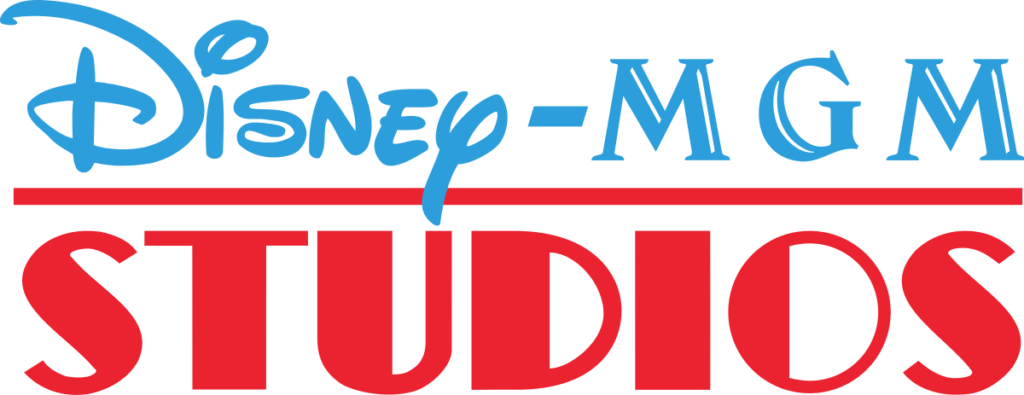
In 1985, Disney and MGM entered into an unprecedented licensing agreement whereby Disney would acquire the worldwide, global rights to use “MGM” and its logo, brand, and name in association with a new theme park: The Disney-MGM Studios. Eisner himself said in his 1998 autobiography, Work in Progress:
“In June 1985, we signed an agreement that gave us most of everything we sought, including perpetual rights to use much of MGM’s library and its logo for a very modest fee. For reasons that remain a mystery, [MGM CEO, billionaire Kirk] Kerkorian was told about the deal only as it was being signed.”
Kerkorian was apparently furious that MGM had sold off its greatest asset – its name and brand – to a competitor for a relatively small fee.
In The Disney Touch by Ron Glover, it’s reported “Under the 20-year agreement, Disney was to pay only $100,000 a year for the first three years and $250,000 for the fourth year. The annual fee would increase by $50,000 in every year thereafter, with an eventual cap of $1 million for the yearly fee.” That’s nothing for an entity the size of the Walt Disney Company, especially in exchange for nearly limitless catalogues of classic Hollywood movies and a competitor’s brand.
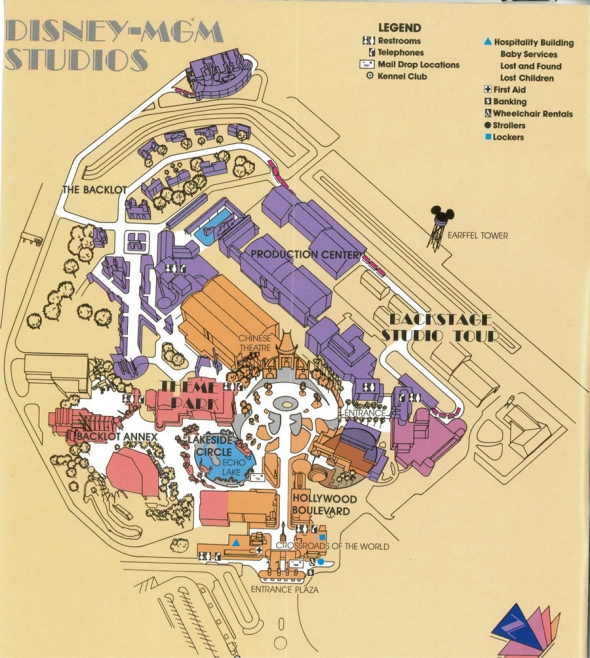
MGM would later turn around and sue Disney over the agreement, but it was too late. The Disney-MGM Studios theme park opened May 1, 1989 as Walt Disney World’s third gate.
(Interestingly, MGM would go on to build its own movie-themed amusement park, MGM Grand Adventures, at their MGM Grand hotel and casino in Las Vegas in 1993. Almost unbelievably, Disney would countersue MGM, claiming that by using their own name in association with their Las Vegas theme park, MGM violated Disney’s worldwide, global rights to use “MGM” in association with theme parks and risked harming Disney’s reputation!)
The Disney-MGM Studios was opened with Eisner on hand. The park was distinctly divided into two sections, as per Eisner’s dedication. He called for the Disney-MGM Studios to be “dedicated to Hollywood —not a place on a map, but a state of mind that exists wherever people dream and wonder and imagine…”
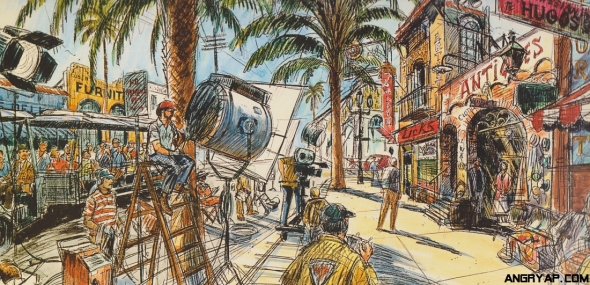
It continued:
…a place where illusion and reality are fused by technological magic…
First and foremost, Eisner had “borrowed” Universal’s behind-the-scenes studio tram tour concept to fuel a two-hour tram-and-walking tour experience that took guests through the real production facilities, costuming shops, and special effects departments that made the actual, working movie studio run. (To see how Eisner’s plan derailed, you need only pick-up the Studios’ story in the complementary in-depth Declassified Disaster: The Backstage Studio Tour.)
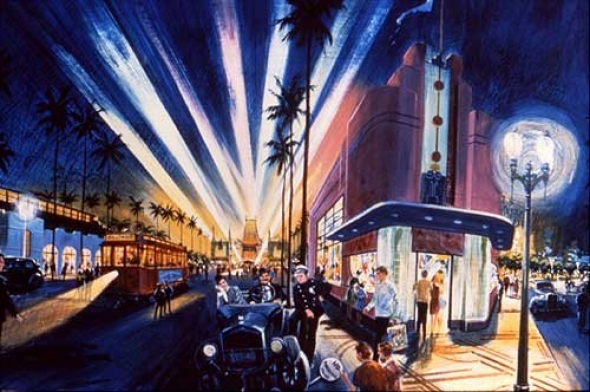
…We welcome you to a Hollywood that never was—and always will be.
Second (and much less significant), the rest of the park was a more proper pedestrian-friendly “theme park” that, at least briefly, dispensed with “behind the scenes” and instead offered a celebration of the Golden Age of Hollywood. While visitors to Magic Kingdom enter on the lovingly recreated turn-of-the-century Main Street, U.S.A., the entrance to Disney-MGM Studios was a similarly authentic Hollywood Blvd.
And that’s where we meet today’s Lost Legend in the flesh… because like Cinderella Castle at the end of Main Street, the Studios’ Hollywood Blvd. ends at the towering, beautiful, magnificent park icon: an astounding recreation of Hollywood’s Chinese Theater. And inside that would-be park icon was the epic dark ride through the movies that would’ve and could’ve felt right at home among Epcot’s best… a ride that expertly fused the park’s “behind-the-scenes” mantra with a celebration of Hollywood’s best.
Hollywood Blvd.
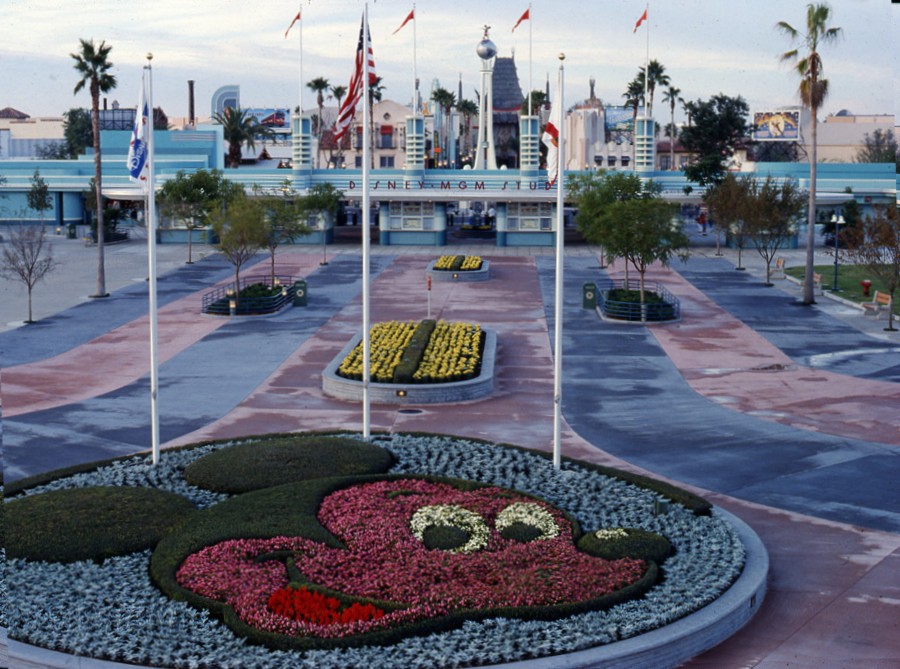
Passing beneath the soaring teal towers of the Pan-Pacific gates, our entry into the Disney-MGM Studios is, of course, Hollywood. There’s no city in the world as tied to the romance, wonder, and excitement of film, and Hollywood Blvd. is the street to see. Art deco towers, neon signs, classic cars… we’ve traveled back to the Golden Age of Hollywood; a city alight with flashbulbs, glitz and glamour, and the promise of stardom.
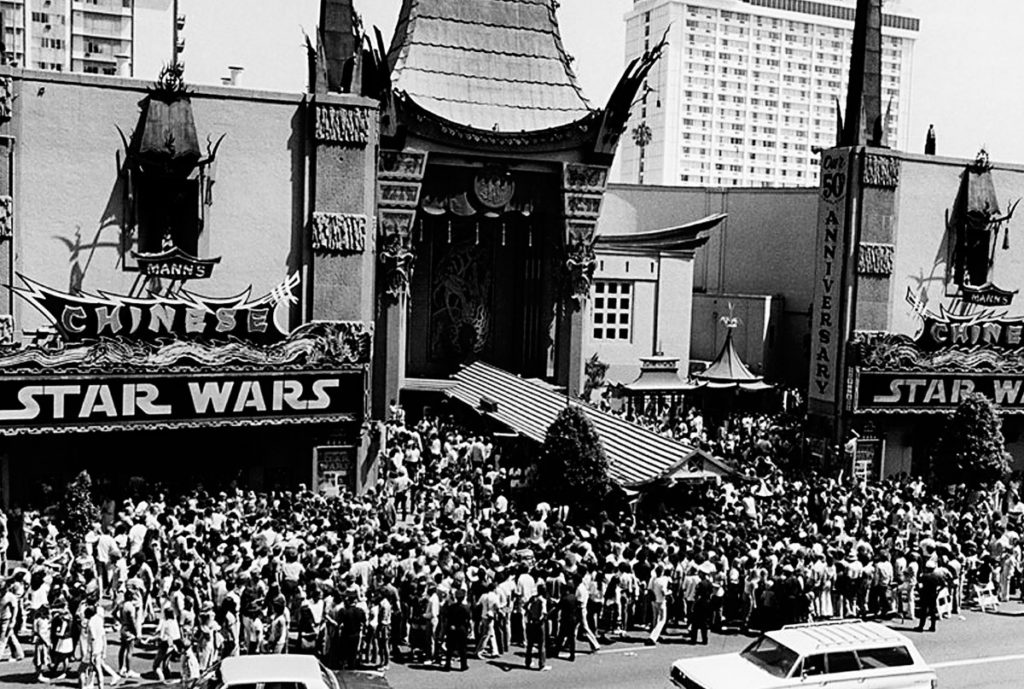
Fittingly, this golden boulevard terminates in a most hypnotic structure: the Chinese Theater. The real Chinese Theater on the real Hollywood Blvd. has been one of the world’s most famed and celebrated movie palaces since its 1927 opening (a sister of the nearby Egyptian Theater).
With thousands of renowned movie premiers over its 60-year life, the Chinese Theater was the perfect cinematic equivalent to Cinderella Castle or Spaceship Earth… a fitting park icon for a park themed to the Golden Age of Hollywood. (But of course, this is not a park themed to Hollywood’s history; it’s a park themed to how movies are made, so the Earful Tower studio-style water tower is the park’s official icon instead.)
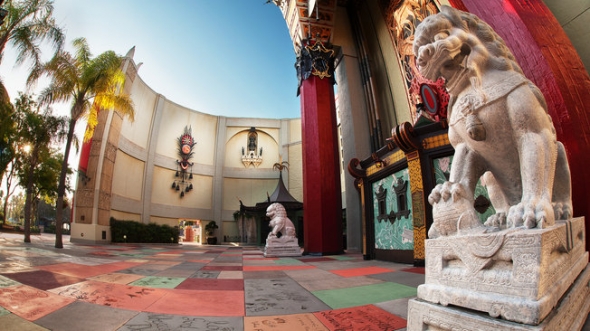
Like the real Chinese Theater, Disney’s full scale recreation includes protective 40-foot tall curved walls creating an inner sanctuary called the Forecourt. There, literally hundreds of celebrity handprints (including Chevy Chase, Burt Reynolds, Daryl Hannah, Goofy, Regis Philbin, and George Lucas) have been pressed into concrete squares – just a small sampling of the prominent figures who have helped shape (or at least visited) Walt Disney World’s cinematic third gate.
But the real sight is the theater itself. A gorgeous combination of Chinese accents atop subtle art deco shapes, the Chinese Theater is a gorgeous piece of architecture in and of itself, with two gigantic coral red columns topped by wrought iron masks holding aloft the bronze roof.
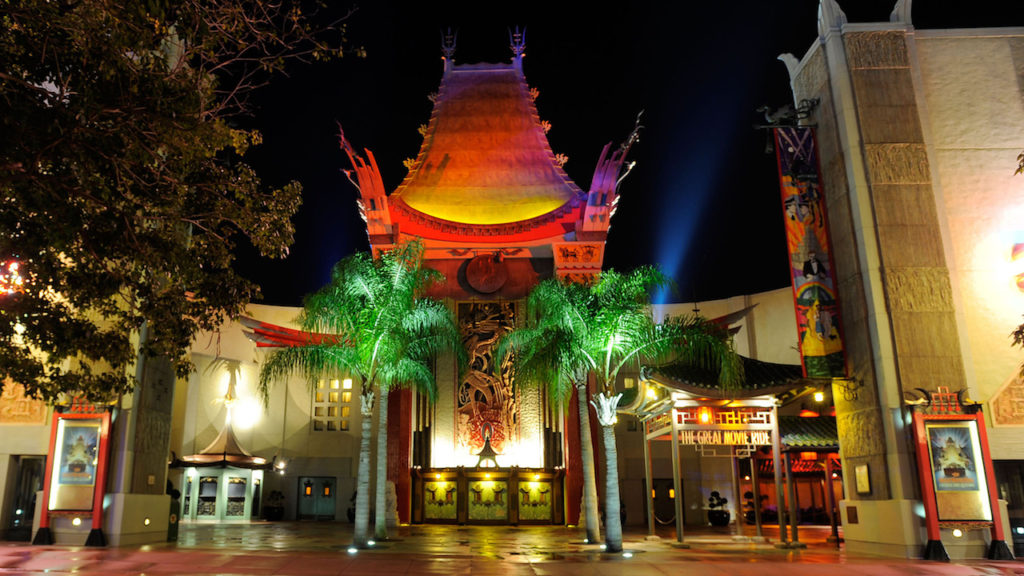
But rather than showcasing the poster for the latest Hollywood blockbuster as the real theater across the country might, the building’s face is adorned with mirrored neon signs and tapestries signaling what lies within. Passing beneath a gabled pagoda beneath the words THE GREAT MOVIE RIDE, we we enter into the theater’s ornate lobby – an Asian-inspired art deco foyer.
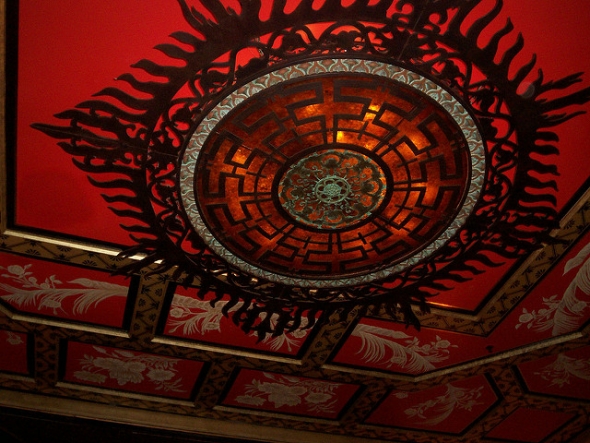
Real artifacts from Hollywood’s greatest hits are housed here – set pieces, props, and costumes from some of the most acclaimed films ever made. Throughout the ride’s life, guests would be able to amble past the Ark of the Covenant from Raiders of the Lost Ark, Alex Delarge’s hat from A Clockwork Orange, a dress worn by Maria in The Sound of Music, Rose’s dress from Titanic, and a Nautilus model and dive suit used in Disney’s own 20,000 Leagues Under the Sea. The astounding thing is that this lobby would pass for a sincere museum of the movies anywhere else – a feat in and of itself – but it’s merely the prologue to The Great Movie Ride…
Speaking of prologue, the lobby winds (expectedly) into a full cinema auditorium. It’s here in this ornate classic theater that the silver screen comes alive with trailer snippets from Casablanca, Mary Poppins, Raiders of the Lost Ark, Singin’ in the Rain, Fantasia, and so many more…
You could call it a preshow, but it’s more of a reminder – a clip show meant to jog memories and emotions, bookmarking films so celebrated as to have entered our collective consciousness. While a real theater’s trailers are to advertise upcoming features, this looping sizzle real is a celebration of the past… and yet, it’s also a tease of what’s to come…
Ready to journey into the movies? Read on…


